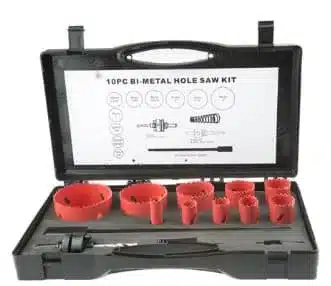
Introduction
Drilling isn’t just about making holes—it’s about precision, material compatibility, efficiency, and long-term results. Mistakes here cost time, tools, and reputation. When it comes to cutting clean, round holes in wood, metal, concrete, or tile, two tools dominate the scene: hole saws and core drill bits. Although they share the common goal of creating holes, they are distinct tools designed for different materials and applications. Moreover, this guide explains what they are, how they differ, and how to select the best one for your specific needs.
Understanding Hole Saws: Definition & Core Functionality
Hole saws are circular saw blades designed to attach to a drill to cut a clean, circular hole in a workpiece without cutting the core material. These saws consist of a cup-shaped body with saw teeth on the cutting edge and a central pilot drill bit. However, the pilot bit first drills a small hole to keep the saw centered and stable, preventing it from wandering as the main cutter engages the material.
The core functionality of hole saws revolves around cutting holes in softer materials. They are a go-to tool for a variety of tasks, including woodworking, plumbing, electrical work, and metal fabrication. Additionally, their core functionality lies in delivering fast, precise cuts with minimal effort, especially when installing pipework, conduit, or door hardware.

What are Core Drill Bits? Understanding Their Core Purpose
Core drill bits, also known as core drills or coring bits, are specialised tools used to drill large-diameter holes in hard, abrasive materials. Unlike a hole saw, which has a serrated edge, a core drill bit typically features a solid, cylindrical body with diamond segments or carbide teeth on the cutting edge. They are often used with a powerful drill rig, as the resistance from the materials they cut is significant.
The primary purpose of core drill bits is to remove a solid cylinder or “core” of material. They are engineered for demanding applications in construction, masonry, civil engineering, plumbing, and HVAC systems. In addition, their core purpose also lies in creating precise holes without displacing the entire material volume, making them highly efficient for deep and clean drilling in hard surfaces such as concrete, stone, brick, and metal.
Hole Saws vs. Core Drill Bits: Finding the Key Differences
While both tools are used for cutting circular holes, their fundamental design and application set them apart. Understanding these variations is essential for selecting the appropriate tool for your project.
- Material Compatibility
Hole Saws: Ideal for softer materials such as wood, drywall, plastic, and thin metal.
Core Drill Bits: Specifically designed for very hard and abrasive materials like concrete, brick, stone, and reinforced concrete.
- Cutting Mechanism
Hole Saws: Use a serrated saw-like cutting edge. The pilot bit guides the cut. They are more akin to a saw blade than a drill bit.
Core Drill Bits: Use diamond segments or carbide teeth to grind and abrade the material. They often require water or air cooling to prevent overheating and dust accumulation.
- Equipment Required
Hole Saws: They are used with standard handheld drills or drill presses.
Core Drill Bits: Often require powerful, high-torque core drilling rigs, especially for larger diameters and harder materials.
- Precision and Debris
Hole Saws: Leave a relatively clean hole, and the core material is easily removed.
Core Drill Bits: Provide high precision for large holes. They create a cylindrical core that is either ejected or needs to be broken out, and they produce a significant amount of slurry or dust if not properly managed.
What are the Different Types of Hole Saws and Core Drill Bits?
Both tools come in various types, each optimised for specific applications and materials. Hole saws are found in bi-metal forms, carbide-tipped models, and diamond-coated hole saws. Similarly, core drill bits come in various types, including diamond core bits, carbide-tipped models, and wet and dry bits. The primary difference between wet and dry bits is that the wet core bits utilise water to cool the bit and suppress dust, thereby extending bit life and creating a cleaner cut. On the other hand, dry bits are designed to be used without water and are often used for bricks and softer materials where water would be a mess or is not needed.
Choosing the Right Tool for the Job: Key Factors to Consider
Selecting the correct tool is paramount for efficiency, safety, and achieving the desired result. When purchasing one, consider the following factors:
Material: This is the most critical factor. For wood and soft metals, a hole saw is the clear choice. For concrete, brick, or stone, you need a core drill bit.
Hole Diameter and Depth: Both tools are available in a wide range of sizes. Ensure your desired tool can accommodate the required diameter. For deep holes, a core drill bit is often more effective.
Tooling Availability: Do you have the necessary drill or drill rig? A standard handheld drill is sufficient for most hole saws, but a core drilling rig is often a non-negotiable requirement for core drill bits.
Project Requirements: Consider the level of precision required. For a rough opening, a simple hole saw might suffice. For a clean, large hole in a structural wall, the precision and power of a core drill bit are essential.
Budget: Hole saws are generally more affordable than core drill bits and their associated rigs. Factor in the cost of the tool itself and any required accessory equipment.
Summary
While hole saws and core drill bits both create circular holes, they are fundamentally different tools designed for different jobs. Hole saws are the versatile choice for softer materials, differentiating them from the heavy-duty specialists: core drill bits, which are designed to tackle the hardest materials. By correctly identifying your material, depth, and the required equipment, you can select the right tool for the job, transforming a challenging task into a precise and successful endeavour.






















